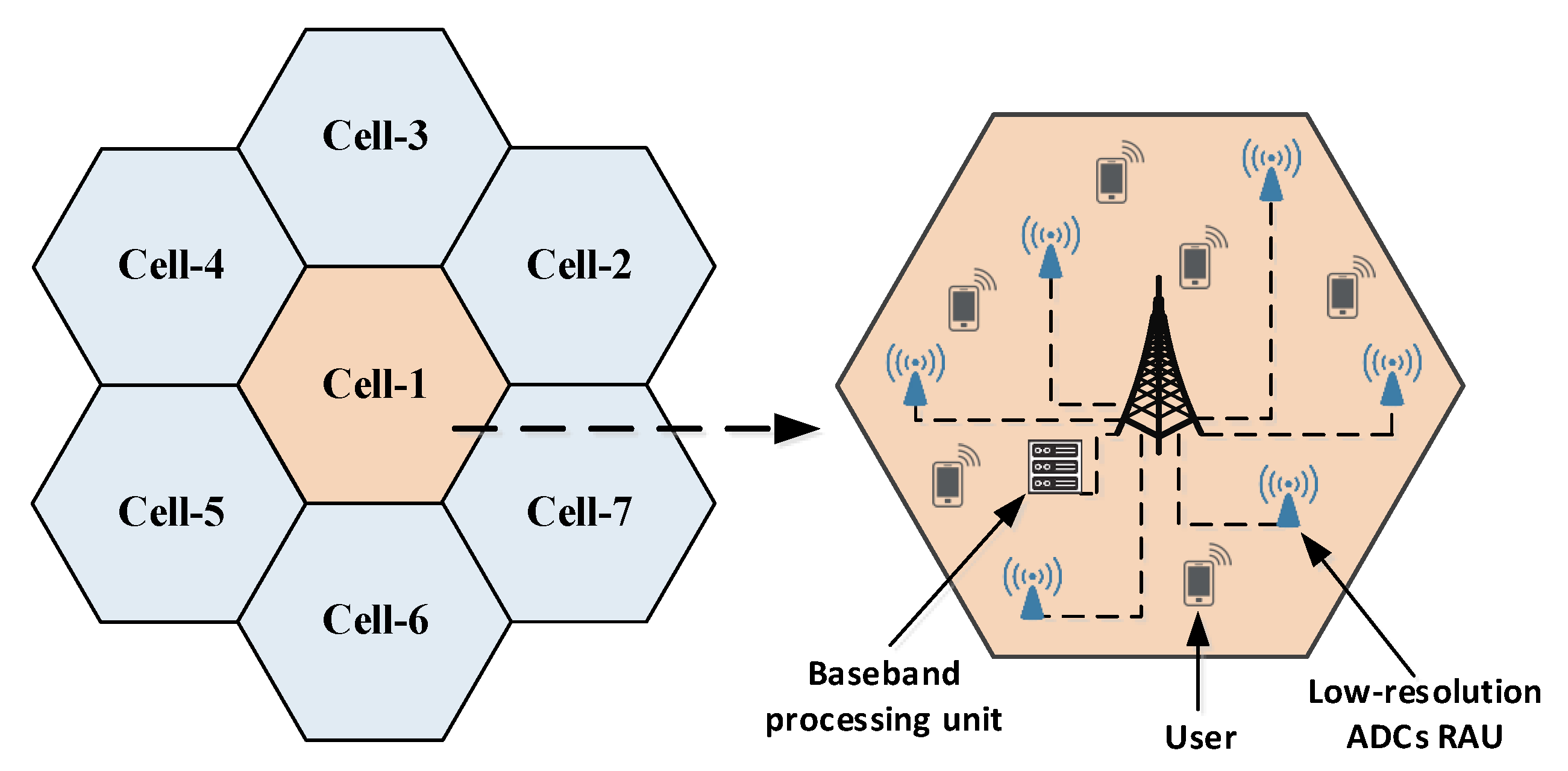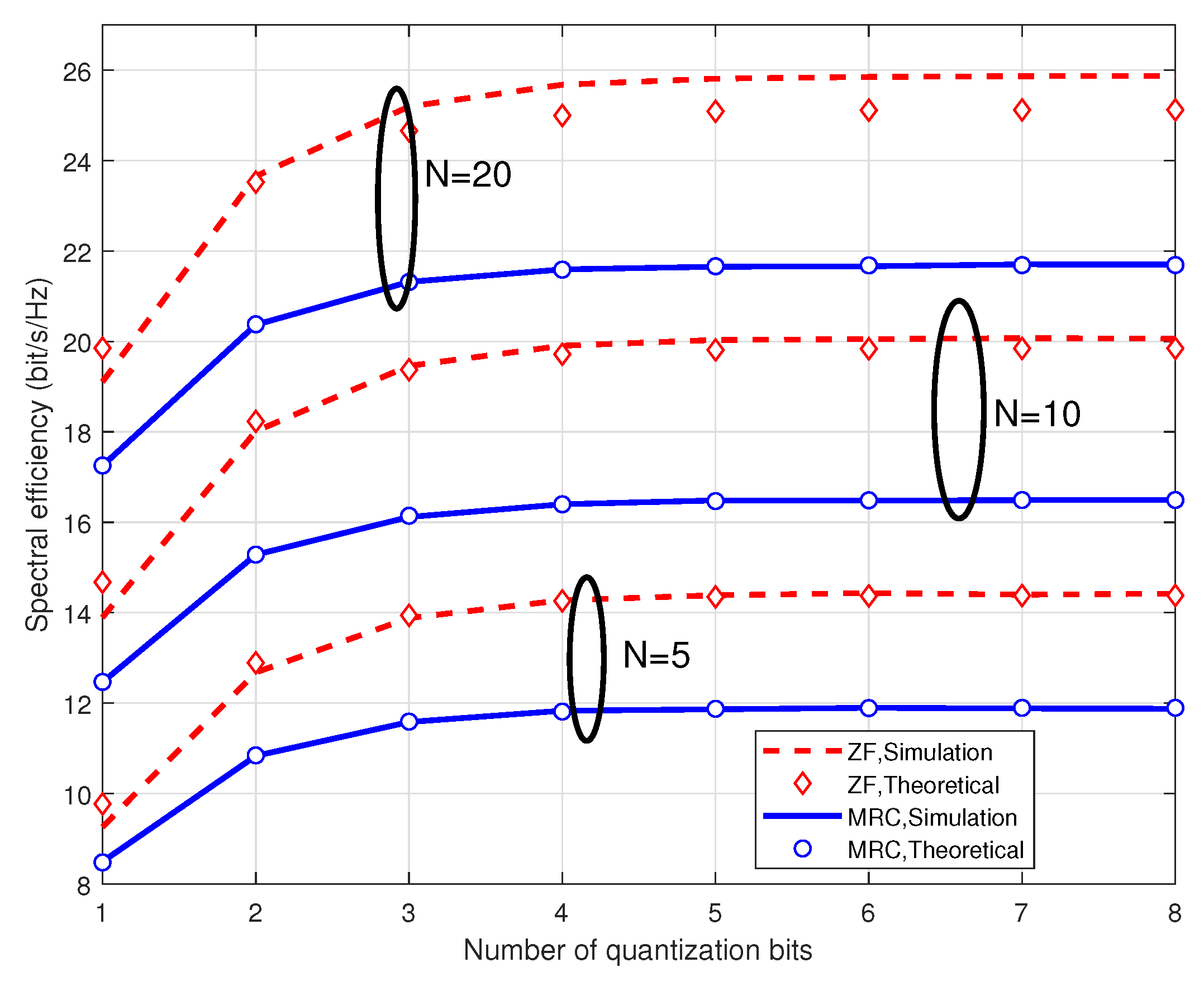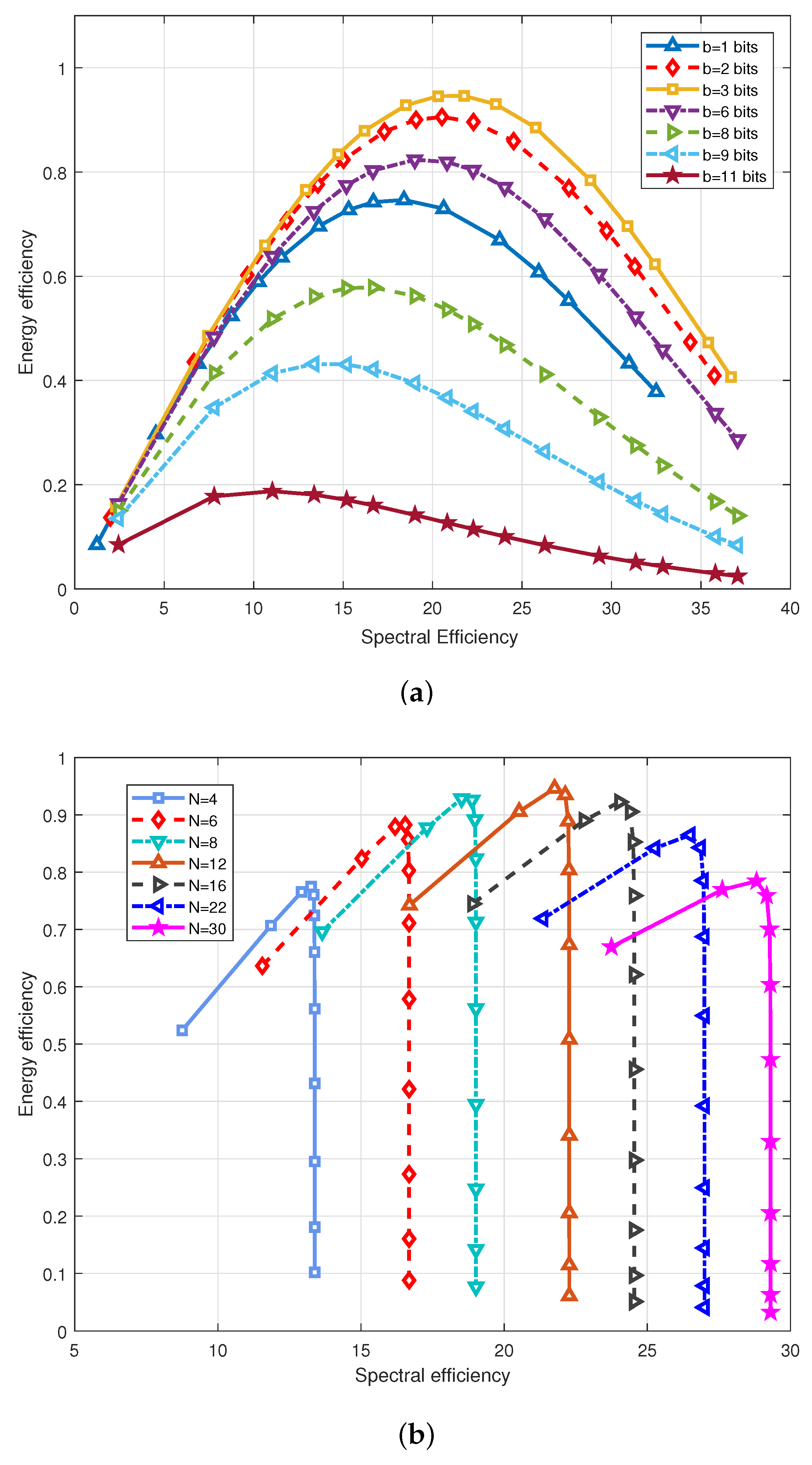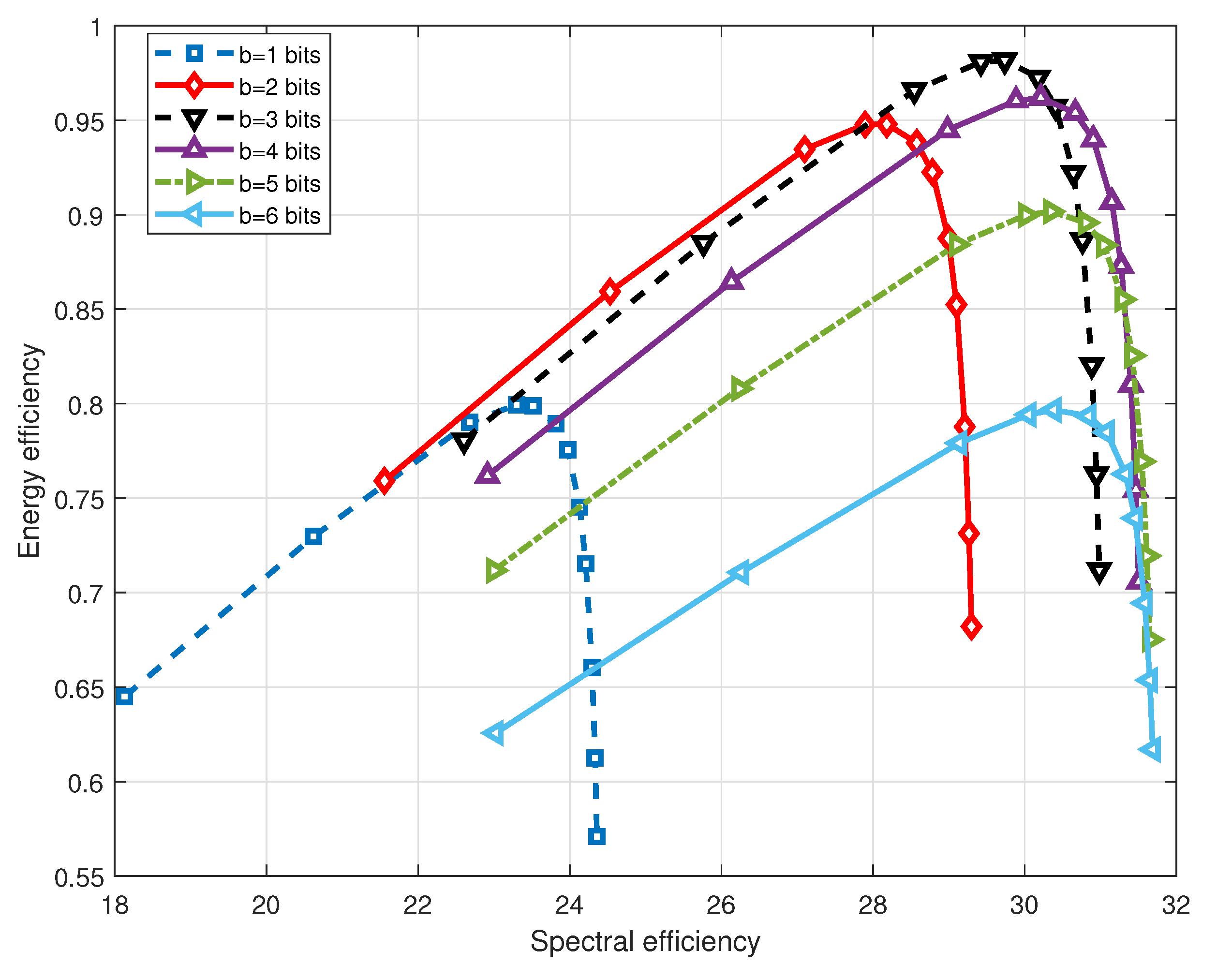Spectral and Energy Efficiency of Distributed Massive MIMO with Low-Resolution ADC
Abstract
1. Introduction
- A joint uplink signal model is provided and it enables us to study the effects of pilot contamination and quantization noise simultaneously.
- Under imperfect CSI and considering MRC and ZF receivers, we derive the closed-form expressions for the uplink achievable rates. The asymptotic performance with quantization bits, the number of antennas per RAU, and per user transmit power are also obtained.
- The theoretical results are verified by performing Monte Carlo simulations, and we obtain deep insight into the impacts of quantization noise on the uplink spectral efficiency and energy efficiency in distributed massive MIMO systems.
2. System Model
2.1. Quantization Noise Model
2.2. The Energy Efficiency Model
3. Energy Efficiency Analysis
4. Numerical Results
5. Conclusions
Author Contributions
Funding
Conflicts of Interest
Appendix A. Lemmas for Proof
Appendix B. Proof of Theorem 1
Appendix C. Proof of the Theorem 2
References
- Wang, J.; Zhu, H.; Gomes, N.J.; Wang, J. Frequency Reuse of Beam Allocation for Multiuser Massive MIMO Systems. IEEE Trans. Wirel. Commun. 2018, 17, 2346–2359. [Google Scholar] [CrossRef]
- Marzetta, T.L. Noncooperative Cellular Wireless with Unlimited Numbers of Base Station Antennas. IEEE Trans. Wirel. Commun. 2010, 9, 3590–3600. [Google Scholar] [CrossRef]
- Larsson, E.G.; Edfors, O.; Tufvesson, F.; Marzetta, T.L. Massive MIMO for next generation wireless systems. IEEE Commun. Mag. 2014, 52, 186–195. [Google Scholar] [CrossRef]
- Lu, L.; Li, G.Y.; Swindlehurst, A.L.; Ashikhmin, A.; Zhang, R. An Overview of Massive MIMO: Benefits and Challenges. IEEE J. Sel. Top. Signal Process. 2014, 8, 742–758. [Google Scholar] [CrossRef]
- Wang, D.; Zhang, Y.; Wei, H.; You, X.; Gao, X.; Wang, J. An overview of transmission theory and techniques of large-scale antenna systems for 5G wireless communications. Sci. China Inf. Sci. 2016, 59, 081301. [Google Scholar] [CrossRef]
- Zhang, J.; Wen, C.; Jin, S.; Gao, X.; Wong, K. On Capacity of Large-Scale MIMO Multiple Access Channels with Distributed Sets of Correlated Antennas. IEEE J. Sel. Areas Commun. 2013, 31, 133–148. [Google Scholar] [CrossRef]
- Rusek, F.; Persson, D.; Lau, B.K.; Larsson, E.G.; Marzetta, T.L.; Edfors, O.; Tufvesson, F. Scaling Up MIMO: Opportunities and Challenges with Very Large Arrays. IEEE Signal Process. Mag. 2013, 30, 40–60. [Google Scholar] [CrossRef]
- Li, J.; Wang, D.; Zhu, P.; Wang, J.; You, X. Downlink Spectral Efficiency of Distributed Massive MIMO Systems With Linear Beamforming Under Pilot Contamination. IEEE Trans. Veh. Technol. 2018, 67, 1130–1145. [Google Scholar] [CrossRef]
- Björnson, E.; Matthaiou, M.; Debbah, M. Massive MIMO with non-ideal arbitrary arrays: Hardware scaling laws and circuit-aware design. IEEE Trans. Wirel. Commun. 2015, 14, 4353–4368. [Google Scholar] [CrossRef]
- Zhu, H. Performance Comparison Between Distributed Antenna and Microcellular Systems. IEEE J. Sel. Areas Commun. 2011, 29, 1151–1163. [Google Scholar] [CrossRef]
- You, X.H.; Wang, D.M.; Sheng, B.; Gao, X.Q.; Zhao, X.S.; Chen, M. Cooperative distributed antenna systems for mobile communications. IEEE Wirel. Commun. 2010, 17, 35. [Google Scholar] [CrossRef]
- Dai, L. A Comparative Study on Uplink Sum Capacity with Co-Located and Distributed Antennas. IEEE J. Sel. Areas Commun. 2011, 29, 1200–1213. [Google Scholar] [CrossRef]
- Bai, Q.; Nossek, J.A. Energy efficiency maximization for 5G multi-antenna receivers. Trans. Emerg. Telecommun. Technol. 2015, 26, 3–14. [Google Scholar] [CrossRef]
- Walden, R.H. Analog-to-digital converter survey and analysis. IEEE J. Sel. Areas Commun. 1999, 17, 539–550. [Google Scholar] [CrossRef]
- Singh, J.; Dabeer, O.; Madhow, U. On the limits of communication with low-precision analog-to-digital conversion at the receiver. IEEE Trans. Commun. 2009, 57, 3629–3639. [Google Scholar] [CrossRef]
- Fan, L.; Jin, S.; Wen, C.; Zhang, H. Uplink Achievable Rate for Massive MIMO Systems With Low-Resolution ADC. IEEE Commun. Lett. 2015, 19, 2186–2189. [Google Scholar] [CrossRef]
- Qiao, D.; Tan, W.; Zhao, Y.; Wen, C.; Jin, S. Spectral efficiency for massive MIMO zero-forcing receiver with low-resolution ADC. In Proceedings of the 2016 8th International Conference on Wireless Communications Signal Processing (WCSP), Yangzhou, China, 13–15 October 2016; pp. 1–6. [Google Scholar] [CrossRef]
- Verenzuela, D.; Bjrnson, E.; Matthaiou, M. Hardware design and optimal ADC resolution for uplink massive MIMO systems. In Proceedings of the 2016 IEEE Sensor Array and Multichannel Signal Processing Workshop (SAM), Rio de Janerio, Brazil, 10–13 July 2016; pp. 1–5. [Google Scholar] [CrossRef]
- Sarajlić, M.; Liu, L.; Edfors, O. When Are Low Resolution ADCs Energy Efficient in Massive MIMO? IEEE Access 2017, 5, 14837–14853. [Google Scholar] [CrossRef]
- Roth, K.; Nossek, J.A. Achievable Rate and Energy Efficiency of Hybrid and Digital Beamforming Receivers With Low Resolution ADC. IEEE J. Sel. Areas Commun. 2017, 35, 2056–2068. [Google Scholar] [CrossRef]
- Li, J.; Wang, D.; Zhu, P.; You, X. Uplink Spectral Efficiency Analysis of Distributed Massive MIMO With Channel Impairments. IEEE Access 2017, 5, 5020–5030. [Google Scholar] [CrossRef]
- Li, J.; Wang, D.; Zhu, P.; You, X. Spectral efficiency analysis of single-cell multi-user large-scale distributed antenna system. IET Commun. 2014, 8, 2213–2221. [Google Scholar] [CrossRef]
- Ngo, H.Q.; Larsson, E.G.; Marzetta, T.L. Energy and Spectral Efficiency of Very Large Multiuser MIMO Systems. IEEE Trans. Commun. 2013, 61, 1436–1449. [Google Scholar] [CrossRef]
- Zuo, J.; Zhang, J.; Yuen, C.; Jiang, W.; Luo, W. Energy-Efficient Downlink Transmission for Multicell Massive DAS With Pilot Contamination. IEEE Trans. Veh. Technol. 2017, 66, 1209–1221. [Google Scholar] [CrossRef]
- Ngo, H.Q.; Tran, L.; Duong, T.Q.; Matthaiou, M.; Larsson, E.G. On the Total Energy Efficiency of Cell-Free Massive MIMO. IEEE Trans. Green Commun. Netw. 2018, 2, 25–39. [Google Scholar] [CrossRef]
- Björnson, E.; Sanguinetti, L.; Hoydis, J.; Debbah, M. Optimal Design of Energy-Efficient Multi-User MIMO Systems: Is Massive MIMO the Answer? IEEE Trans. Wirel. Commun. 2015, 14, 3059–3075. [Google Scholar] [CrossRef]
- Pham, Q.; Hwang, W. Fairness-Aware Spectral and Energy Efficiency in Spectrum-Sharing Wireless Networks. IEEE Trans. Veh. Technol. 2017, 66, 10207–10219. [Google Scholar] [CrossRef]
- Deng, L.; Rui, Y.; Cheng, P.; Zhang, J.; Zhang, Q.T.; Li, M. A Unified Energy Efficiency and Spectral Efficiency Tradeoff Metric in Wireless Networks. IEEE Commun. Lett. 2013, 17, 55–58. [Google Scholar] [CrossRef]
- Xu, L.; Yu, G.; Jiang, Y. Energy-Efficient Resource Allocation in Single-Cell OFDMA Systems: Multi-Objective Approach. IEEE Trans. Wirel. Commun. 2015, 14, 5848–5858. [Google Scholar] [CrossRef]
- Heath, W.H., Jr.; Wu, T.; Kwon, Y.H.; Soong, A.C.K. Multiuser MIMO in Distributed Antenna Systems With Out-of-Cell Interference. IEEE Trans. Signal Process. 2011, 59, 4885–4899. [Google Scholar] [CrossRef]
- Lim, Y.; Chae, C.; Caire, G. Performance Analysis of Massive MIMO for Cell-Boundary Users. IEEE Trans. Wirel. Commun. 2015, 14, 6827–6842. [Google Scholar] [CrossRef]




| Parameters | Values |
|---|---|
| Transmitted power per user | 0.02 Watts |
| Power consumption per antenna at base station | 0.1 Watts |
| Power consumption per antenna at users | 0.1 Watts |
| Power consumption per local oscillator | 1 Watts |
| Computational efficiency at base stations | 12.8 Gflops/Watt |
| Power amplified efficiency | 0.4 |
| Fixed power consumption per backhaul | 0.825 Watts |
| Traffic-dependent backhaul power | 0.25 Watts/(Gbit/s) |
| Parameters of ADC |
© 2018 by the authors. Licensee MDPI, Basel, Switzerland. This article is an open access article distributed under the terms and conditions of the Creative Commons Attribution (CC BY) license (http://creativecommons.org/licenses/by/4.0/).
Share and Cite
Li, J.; Lv, Q.; Yang, J.; Zhu, P.; You, X. Spectral and Energy Efficiency of Distributed Massive MIMO with Low-Resolution ADC. Electronics 2018, 7, 391. https://doi.org/10.3390/electronics7120391
Li J, Lv Q, Yang J, Zhu P, You X. Spectral and Energy Efficiency of Distributed Massive MIMO with Low-Resolution ADC. Electronics. 2018; 7(12):391. https://doi.org/10.3390/electronics7120391
Chicago/Turabian StyleLi, Jiamin, Qian Lv, Jing Yang, Pengcheng Zhu, and Xiaohu You. 2018. "Spectral and Energy Efficiency of Distributed Massive MIMO with Low-Resolution ADC" Electronics 7, no. 12: 391. https://doi.org/10.3390/electronics7120391
APA StyleLi, J., Lv, Q., Yang, J., Zhu, P., & You, X. (2018). Spectral and Energy Efficiency of Distributed Massive MIMO with Low-Resolution ADC. Electronics, 7(12), 391. https://doi.org/10.3390/electronics7120391





